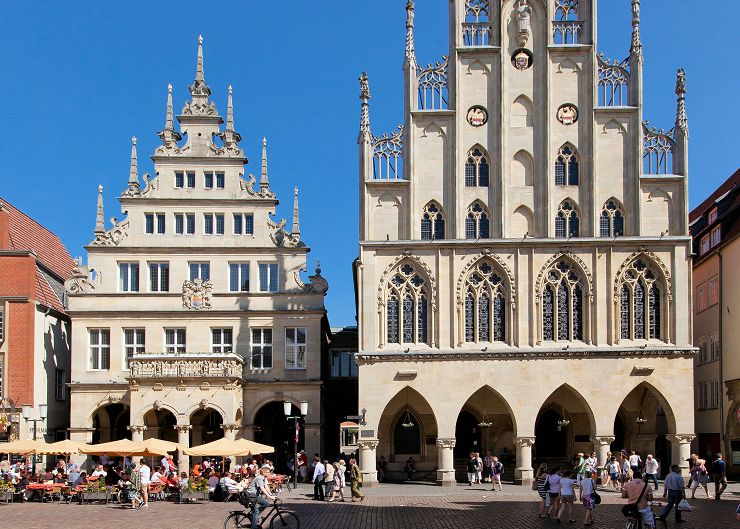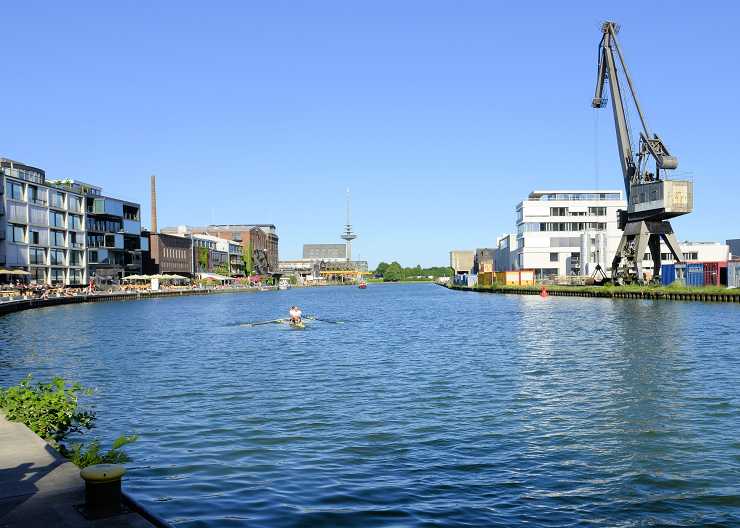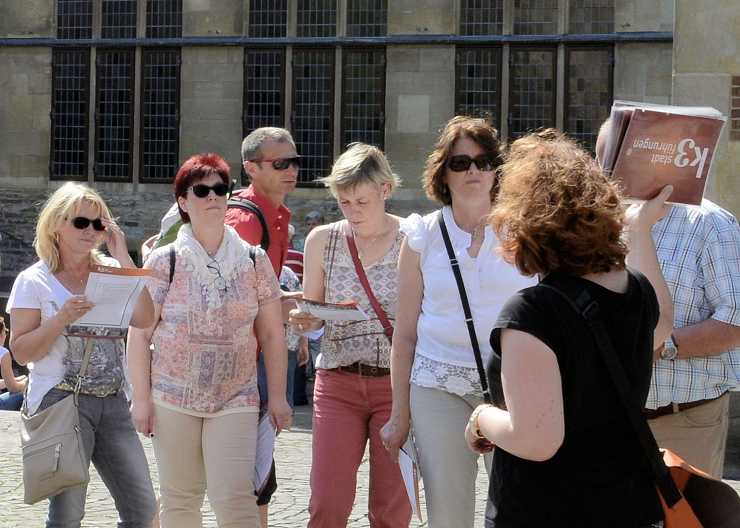| Guided tours and city experiences. Culture and fun in Münster |
They are everywhere: leaning against trees or walls, parked close together or even on top of each other. Bicycles, also known as “Leezen” in Münster, are just as much a part of the cityscape as the many churches and historic gabled houses. The Promenade, the green belt in the area of the former city wall, is also referred to by locals as the “bicycle highway”. Students in particular, who make up around a sixth of the population, use it to whizz from lecture hall to lecture hall. But interested visitors also like to use the promenade for a bike ride.
Numerous green spaces, a distinctive city center, quaint pubs and restaurants: it’s easy to see why Münster was declared the most liveable city in the world at the Canadian LivCom Awards in 2004. In any case, the people of Münster are proud of where they live and testify to this satisfaction time and time again.


The secret of the city of Münster lies somewhere in the intersection of historical growth and new developments, somewhere between urban planning and Westphalian joie de vivre. The tradition-conscious city in the heart of Westphalia boasts numerous sights and is a popular excursion destination. Münster has also made a name for itself among fans of German TV crime dramas. On a Münster crime scene tour, visitors can explore the city in the footsteps of Inspector Thiel and his colleague Professor Boerne.
Guided tour of Münster’s old town
The historic old town with its arcades and gabled houses, no two of which are alike, can be easily discovered on foot. On a city tour, visitors learn how an inconspicuous Saxon settlement grew into an important episcopal and Hanseatic city in the Middle Ages. You will hear about the coexistence and opposition of merchants and bishops, about Anabaptists and iconoclasts, about the Peace of Westphalia and Westphalian pumpernickel.
The most beautiful sights of Münster
Where 1200 years ago there were just a few thatched farmhouses, today St. Paul’s Cathedral towers majestically. The mighty cathedral, which combines Romanesque and Gothic elements, attracts many visitors, especially at lunchtime. At 12 o’clock sharp, people crowd in front of the astronomical clock, a masterpiece dating back to 1542, to listen to a carillon that has lost none of its magic over the centuries.
It is not far from the cathedral to Münster’s most beautiful street, Prinzipalmarkt. Even in the Middle Ages, this shopping street with its richly decorated gabled houses and archways was one of the city’s most important market streets. Often referred to by locals as Münster’s “parlor”, Prinzipalmarkt has retained its typical character to this day. Numerous stores and boutiques, including many traditional family businesses, are located here.


What would Prinzipalmarkt be without the historic town hall, which has always been the pride of Münster’s citizens? The richly decorated stepped gable has represented the wealth of the merchants since the Middle Ages. The town hall was one of the first buildings to be rebuilt after the destruction of the Second World War – by means of a town hall lottery in which, among other things, Westphalian ham could be won.
The town hall is symbolic of the Peace of Westphalia, which was concluded in Münster and Osnabrück in 1648. In the Peace Hall, visitors can learn how envoys from all over Europe managed to end a war that raged on the continent for 30 years and devastated entire regions through skillful negotiations.
If you walk up Prinzipalmarkt from the town hall and look up into the sky, you will discover three wrought-iron baskets on the tower of Lamberti Church. To this day, they are a reminder of one of the darkest chapters in Münster’s history: the time of the Anabaptist kingdom. In the 16th century, the radical Christian sect drove all people of other faiths out of the city, destroyed works of art and burned books.
In order to better defend themselves, they even toppled the spire of the Church of Our Lady in order to position cannons on it. But to no avail: the town was eventually taken and the Anabaptist leaders executed. Their bodies were placed in three wrought-iron baskets, which were attached to the Lamberti church tower as a deterrent.
By the way, if you pass by the Lamberti Church late at night, don’t be surprised if you hear the dark sound of a medieval horn: Between 9 p.m. and midnight, a watchman keeps an eye out for enemies and fire above the rooftops of Münster – a tradition that has existed in the city since the 14th century.
Other historical figures also stroll through Münster’s streets after sunset. Night watchmen, musketeers and other contemporary witnesses of the 16th and 17th centuries show visitors on a night watchman tour their city from a unique perspective.


Peace of Westphalia
The Peace of Westphalia, which was signed in Münster in 1648, is considered one of the most important treaties in European history. This peace treaty ended the Thirty Years’ War, which had devastating consequences in Europe and led to a political reorganization of the continent.
The Peace of Westphalia set new standards for the diplomatic settlement of conflicts and was an important milestone on the way to the modern European order of states. This treaty also recognized the principles of religious freedom and state sovereignty for the first time, which still has an influence on international politics today.
Astronomical clock
The Münster astronomical clock is an impressive masterpiece of technology and art that can be found in the heart of the city. Located in the south ambulatory of St. Paul’s Cathedral, the clock has been restored several times over the years and enhanced with art and technical innovations. It was originally built in the 16th century and is a symbol of Münster’s rich history and culture.
The astronomical clock consists of three main parts: the calendar dial, the planetarium and the time display. Each part of this work of art fulfills a different function and provides information about different things, such as the month and day of the year, the movement of the sun, moon and planets and, of course, the time.


Tips for your stay in Münster
Pedal boating, going for a walk or would you prefer to have a coffee near the shore? Lake Aasee is the perfect destination for warm summer days. If it does rain, you can visit the nearby all-weather zoo. As the name suggests, it is possible to marvel at many of the exotic animal species without getting wet.
Nearby is the Mühlenhof open-air museum, where visitors can experience with all their senses how people lived in the Münsterland region in the 16th to 19th centuries. Most of the 30 historical buildings are original structures that have been relocated here.
Where the city’s sewage was once purified is now a huge nature reserve: the Rieselfeldern, just six kilometers from the city center, is home to numerous endangered bird species. The best starting point for excursions is the Biological Station. You can find further suggestions for your visit to Münster under Münster sightseeing tips and restaurant recommendations.
The Pablo Picasso Art Museum exhibits, among other things, 800 prints and thus almost the entire lithographic work of the Spanish artist. Special exhibitions are also dedicated to the life and work of Picasso and his contemporaries.
Every Wednesday and Saturday morning, the cathedral square is a hive of activity. The weekly market, one of the most beautiful markets in Europe, has over 150 stalls. In addition to fruit and vegetables from the region, cheese and sausage specialties and other delicacies, you can also buy clothes, jewelry and leather goods here.
After work, many Münster residents are drawn to the Kuhviertel, home to the traditional Pinkus brewery and the city’s oldest student pub, the Cavete.
The Kreativkai, the promenade along the harbor, is also very popular. Choose one of the many cafés and restaurants housed in former warehouses and enjoy the view of the water. Tip: It’s worth booking in advance!








